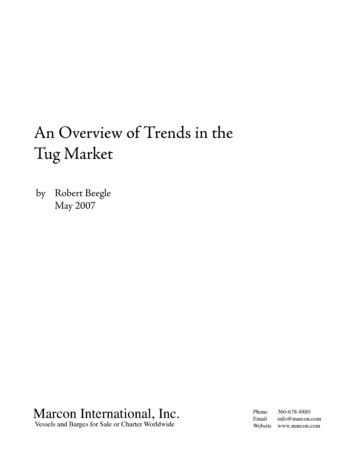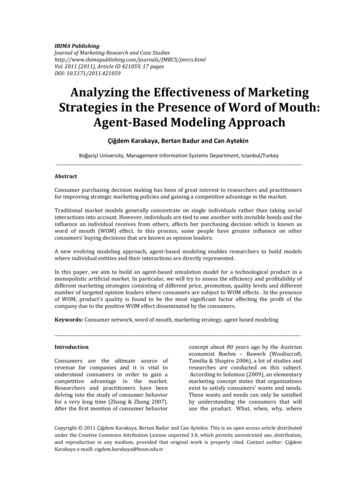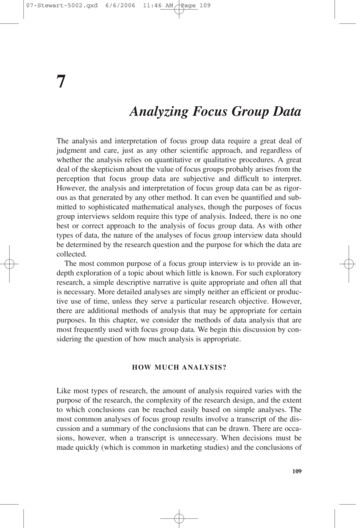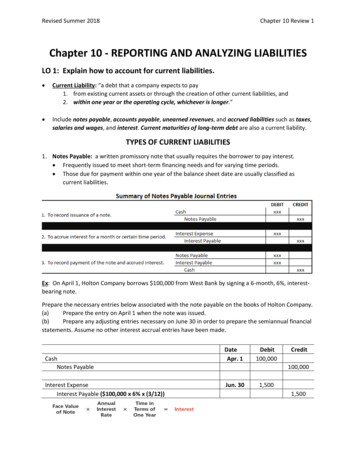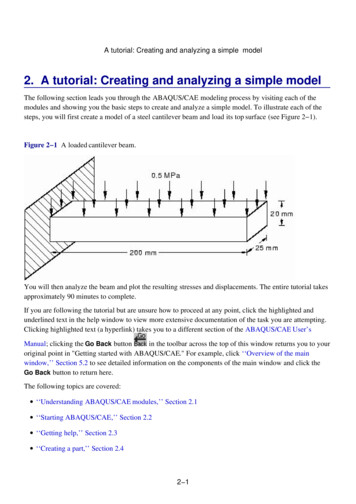
Transcription
Guide Note 12Analyzing Market TrendsIntroductionSince the value of a property is equal to the present valueprofoundly impacts the highest and best use, and in turnof all of the future benefits it brings to its owner, marketthe market value of a property. Analyzing current andvalue is dependent on the expectations of what willanticipated market conditions is more complicated – andhappen in the market in the future. Therefore, a criticalmore critical – when a market is rapidly changing, eitherstep in the development of a market value opinion isupward or downward. A “bubble” market might suddenlyanalysis of the market trends. The market trends studyturn and decline; a “bust” market might suddenly start toshould include what market participants (buyers, etc.)improve. To what extent is an appraiser responsible forbelieve will happen to market conditions in the future asrecognizing changes in market conditions? What steps mustwell as current supply and demand, and anticipated changesan appraiser take to ensure due diligence is done regardingto supply and demand. The interaction of these factorsthe analysis of market trends?
GUIDE NOTE 12Applicable Valuation StandardsThe Standards of Valuation Practice (SVP), Standards Rule A-4, Application of Methodology states: “The valuer must: (a) research andverify data necessary to develop a credible appraisal, and (b) correctly employ methods and techniques necessary to produce a credible appraisal.”The Uniform Standards of Professional Appraisal Practice (USPAP) include more rules that address these questions.USPAP Standards Rule 1-3 states:When necessary for credible assignment results in developing a market value opinion, an appraiser must:(a) identify and analyze the effect on use and value of existing land use regulations, reasonably probable modificationsof such land use regulations, economic supply and demand, the physical adaptability of the real estate,and market area trends; andComment: An appraiser must avoid making an unsupported assumption or premise about market area trends, effectiveage, and remaining life.(b) develop an opinion of the highest and best use of the real estate.Comment: An appraiser must analyze the relevant legal, physical, and economic factors to the extent necessary tosupport the appraiser’s highest and best use conclusion(s).”SVP’s Standards Rule A-3: Scope of Work requires the valuer to “determine the scope of work necessary to develop an appraisal thatis credible given its intended use.” USPAP’s Scope of Work Rule states that an appraiser must “determine and perform the scope ofwork necessary to develop credible assignment results.” Scope of work includes the type and extent of data researched and the typeand extent of analyses applied to arrive at opinions and conclusions. Thus, under either the SVP or USPAP, the extent of the analyses ofmarket conditions and trends is a scope of work issue. Along with other aspects of scope of work, the extent of these analyses must bedetermined at the outset of each assignment.USPAP Standards Rule 1-6 requires the appraiser to:(a) reconcile the quality and quantity of data available and analyzed within the approaches used; and(b) reconcile the applicability of the approaches, methods and techniques used to arrive at the value conclusion(s).Factors That Cause Markets to ChangeReal estate markets are characterized by cycles. Real estate cycles typically involve successive periods of expansion, peaklevels of activity, contraction, and troughs.Factors that cause markets to change are distinctly different from symptoms of change. Examples of symptoms of changeinclude changes in vacancy rates (a leading indicator), falling or rising property prices, increases in the frequency of concessionsand seller financing, sales prices exceeding listing price, and other conditions symptomatic of larger, more basic problems.Factors that cause markets to change are generally the product of macro-level forces. They influence market psychology anddrive behavior in profound, sometimes dramatic ways. Such causative factors can involve a single defining event or a slowermoving series of events that are evolutionary in nature and sometimes not readily apparent to real time observers. Whether theyconsist of a single defining event or series of related events, these causative factors are indicative of shifts in underlying politicaland social as well as economic conditions.
Factors That Cause Markets to Change (continued)Factors that cause markets to change may be capital (transactional) based or fundamental (space user) based. Examples ofcapital based factors that cause markets to change include:1. Changes in public policy, particularly related to monetary policy and government spending, taxation, interest rates, theavailability of financing and capital formation, length and facilitation of the local entitlement process, and employmentinitiatives.2. Inflationary/deflationary pressures on the regional, national, and global economies.3. Overabundance of investment capital resulting in increased competition (often too much money chasing too few deals),overly aggressive investment strategies, progressively lax underwriting standards.Examples of fundamental (space user) based factors that cause markets to change include:1. Changes in migration patterns and population shifts which cause overcapacity in some areas and undersupply in others.2. Economic shock caused by events such as 9/11, the Lehman bankruptcy, the dot.com bust of the early 2000s, the Araboil embargo of the 1970s, and periodic spikes in the price of oil, all of which caused wide-scale disruption in propertymarkets affecting everything from corporate strategy, personal live/work decisions, and increased cost of propertyoperation to demand for hotel rooms and second homes.3. Aging population with its increased demand for retirement communities, congregate care facilities and smallerhousing size.4. Changes in technology such as green buildings, cloud computing, and internet shopping, which affect employmentpatterns, new industry formations, and new property types (e.g., server farms, disaster recovery facilities.)5. Natural disasters and industrial accidents, which are usually local or regional in nature.6. Changes in affluence and income distribution that influence affordability and consumer and discretionary spending habits.7. Overbuilding and increases in competitive supply.Market AnalysisMarket analysis is is defined as “The study of the supply and demand in a specific area for a specific type of property.”1While appraisers generally analyze historic data (e.g. comparable sales) in the valuation process, it is important to recognizethat the value of a property is dependent on the future benefits that a property will bring to its owner. Future benefits include therights to use, occupy, and enjoy the property as well as the right to receive income it may produce. Market values are thereforeforward-looking. Data used in the valuation process must be adjusted for market conditions as necessary so the market valueconclusion reflects this forward-looking stance as of the date of value. Market analysis provides the framework for makingdeterminations about market conditions adjustments.Market analysis is a critical step in the appraisal process. Adequate market analysis must be completed before highest and bestuse analysis, and the determination of highest and best use is critical to an appraisal assignment when market value isthe objective.Market analysis provides the data input to identify the highest and best use of a property in terms of (1) property use (2) marketsupport (economic demand) and timing (absorption rates), and (3) market participants (probable users and buyers.)212Appraisal Institute, The Dictionary of Real Estate Appraisal, 6th ed. (Chicago: Appraisal Institute, 2015).Stephen F. Fanning, Market Analysis for Real Estate: Concepts and Applications in Valuation and Highest and Best Use. (Chicago: Appraisal Institute,2014.), pp. 6-8
Market Analysis (continued)Most market analyses can be completed using a six-step process:1. Define the product (property productivity analysis): Identify physical, legal and location attributes that shape productivecapabilities and potential uses.2. Market delineation: Identify the market for the use.3. Demand analysis: Identify characteristics of the most probable user. Analyze demand drivers such as population,income, employment.4. Supply analysis: Survey and forecast competition. Analyze existing supply, new inventory coming on line in the near future,and proposed construction.5. Analysis of the Interaction between supply and demand: Determine if marginal demand exists, predict when market willmove out of equilibrium.6. Forecast subject capture: Analyze market penetration.A seventh step, perform financial feasibility analysis of alternative uses and threshold testing, can be added for proposedproperties.The manner and degree to which these steps are carried out within an appraisal assignment are scope of work issues.The scope of work for an assignment must be appropriate given the intended use. It is the appraiser’s responsibility todetermine the scope of work for the assignment. The scope of work must meet or exceed what the appraiser’s peers’ actionswould be in the same or a similar assignment, and with the expectations of parties who are regularly intended users forsimilar assignments.The appraiser must decline or withdraw from an assignment if the client will not allow the appraiser’s scope of work to beadequate for the assignment. The level of market analysis performed must be appropriate for the assignment and not limitedsolely because the client wishes to reduce the appraisal cost.The level of analysis can range from simple to highly sophisticated. On a simple level, demand may be inferred from currentmarket conditions, or rates of change used to develop projections. On the more sophisticated level, an in-depth analysis offorecast (fundamental) demand is performed.Fundamental market analysis may be useful and necessary when analyzing or performing an appraisal of a property for newconstruction, or when appraising property in a volatile or rapidly changing market. In terms of real estate products, whether itbe apartments, industrial, retail or office properties, fundamental market analysis answers the questions of “when and howmuch.”Competent appraisers continuously interact with buyers, sellers and agents of transaction activity. Ideally, appraisers havefrequent and sustained interaction with buyers or lessees in particular. Such interaction allows appraisers to ascertain, analyze,and understand the motivations of market participants. Appraisers must be familiar with the local market dynamics and be ableto perform trend analysis and/or fundamental market analysis to the degree necessary for the specific assignment.However, appraisers are not expected to be prognosticators. Unforeseen events can completely eradicate conclusions that havebeen based in trend analysis or fundamental market analysis. A market value opinion is as of a particular date, and it is anattempt to reflect the anticipations of market participants as well as market fundamental trends and analysis. Eventssubsequent to the date of value that were not anticipated by market participants can cause values to change -- in somecases, significantly.
Signs of a Changing MarketSigns of a changing market are symptoms, as opposed to causes. An appraiser observes the symptoms, but must understandthe underlying cause or causes in order to properly analyze market trends.For appraisers and market participants, a “bust” market is usually relatively obvious. However, it can be difficult to spot a“bubble” market when in the midst of one. Further, it can be difficult to tell when a bust market has started to turn and improve,or when a bubble market has begun to decline.A bubble may be evidenced by:1. Rate of return associated with a property type, economic characteristics of tenants or users are not typical and tendto be very low. For example, capitalization rates may be very low and or indicate negative leverage, which is often a signof speculation.2. Buyers become emotionally involved and act irrationally, contrary to the market value definition.3. Prices increase at a faster rate than rents.4. Rates of return decrease below long-range trends.5. Prices rise while rents and net incomes remain stable or are declining.6. Traditional buyers are replaced by new ones. “Everyone” starts to invest in real estate.7. The number of transactions increases.8. Shorter marketing times.9. Average days-on-market decreases.10. Very few expired listings.11. An increase in the number of properties remaining vacant after purchase.12. Condominium conversions become more common.13. The number of persons employed in the real estate sector (real estate sales, mortgage lending) significantly increases.14. Rents increasing faster than the ability of tenants to pay.15. Sales prices above affordability of users.A bust market may be evidenced by:1. Sellers are reluctant to sell and realize losses; therefore, there are few sales, at least initially.2. An increase in the rate of foreclosures, to the point where foreclosures become the predominant sales.3. An increase in seller concessions, both in terms of frequency and magnitude.4. A tightening of credit markets. Traditional financing becomes more difficult to obtain.5. An increase in the use of “creative” financing, generally involving seller financing. These arrangements serve to keepnominal prices from falling, at least in the initial stages of a bust.6. Longer marketing times.7. Average days-on-market increases.8. The number of expired listings increases.9. The number of persons employed in the real estate sector declines.10. Job growth declining.11. Rents not rising at the rate of the last few years.12. Vacancy increasing.
ReconciliationThere are tw
2Stephen F. Fanning, Market Analysis for Real Estate: Concepts and Applications in Valuation and Highest and Best Use. (Chicago: Appraisal Institute, 2014.), pp. 6-8. Market Analysis (continued) Most market analyses can be completed using a six-step process: 1. Define the product (property productivity analysis): Identify physical, legal and location attributes that shape productive .File Size: 1MBPage Count: 6
